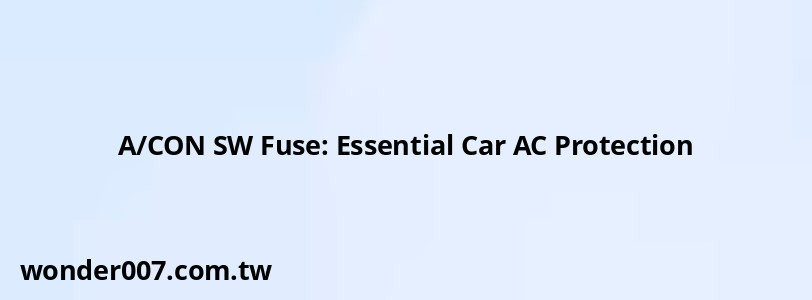A/CON SW Fuse: Essential Car AC Protection

The A/CON SW fuse, short for Air Conditioner Switch fuse, is a crucial component in your vehicle's electrical system. This fuse specifically protects the air conditioning control module and related circuits from electrical overloads.
Purpose of A/CON SW Fuse
The primary function of the A/CON SW fuse is to safeguard the air conditioning system's electrical components. It acts as a safety device that prevents excessive current from damaging sensitive parts of the AC control module.
Location and Identification
Typically, you can find the A/CON SW fuse in the vehicle's main fuse box, which is usually located under the dashboard or in the engine compartment. The fuse is often labeled "A/C" or "A/CON" on the fuse box diagram.
Amperage Rating
The A/CON SW fuse generally has a low amperage rating, commonly around 7.5 to 10 amps. This relatively low rating is sufficient to protect the AC control circuits while allowing normal operation.
Importance of Correct Amperage
Using the correct amperage is crucial. A fuse with too high an amperage rating may not blow when needed, potentially causing damage to the AC system. Conversely, a fuse with too low an amperage might blow unnecessarily, disrupting AC operation.
Signs of a Blown A/CON SW Fuse
If your vehicle's air conditioning system suddenly stops working, a blown A/CON SW fuse could be the culprit. Other signs include:
- AC controls not responding
- No power to the AC control panel
- Intermittent AC operation
Replacing the A/CON SW Fuse
Replacing a blown A/CON SW fuse is generally a simple process:
1. Locate the fuse box and identify the correct fuse
2. Remove the old fuse using fuse pullers or needle-nose pliers
3. Insert a new fuse of the same amperage rating
4. Test the AC system to ensure proper operation
Always consult your vehicle's manual before attempting any fuse replacement to ensure you're using the correct type and amperage.
Frequent Blowing of A/CON SW Fuse
If the A/CON SW fuse blows frequently, it may indicate a more serious electrical problem in your vehicle's AC system. This could be due to:
- Short circuits in the AC wiring
- Faulty AC components drawing excess current
- Damaged AC control module
In such cases, it's advisable to have your vehicle inspected by a qualified mechanic or auto electrician.
FAQs About A/CON SW Fuse
- Can I use a higher amperage fuse if the original keeps blowing?
No, always use the manufacturer-specified amperage. Using a higher-rated fuse can lead to electrical system damage. - How often should I check the A/CON SW fuse?
It's good practice to check all fuses, including the A/CON SW fuse, during regular vehicle maintenance or if you experience AC issues. - What happens if I drive with a blown A/CON SW fuse?
While it won't affect the car's drivability, your AC system won't function. It's best to replace the fuse promptly to avoid potential damage to other AC components.
Related Posts
-
2017 Hyundai Elantra: Essential Lug Nut Size Guide
28-01-2025 • 121 views -
Power Steering Pump for 2008 GMC Acadia: Essential Guide
29-01-2025 • 100 views -
Catalytic Converter: Essential Guide for 2003 Ford Expedition
26-01-2025 • 128 views -
1997 Dodge Ram 1500 Catalytic Converter: Essential Guide
28-01-2025 • 92 views -
Normal Operating Temperature for a Semi Truck: Essential Insights
27-01-2025 • 175 views
Latest Posts
-
Power Steering Fluid Leak On Passenger Side
01-02-2025 • 296 views -
Rear Brake Caliper Piston Won't Compress
01-02-2025 • 241 views -
Are O2 Sensors Covered Under Warranty
01-02-2025 • 259 views -
2015 Chevy Traverse AC Recharge Port Location
01-02-2025 • 268 views -
How To Turn Off Paddle Shifters Mercedes
01-02-2025 • 245 views
Popular Posts
-
V12 Engine Costs: What You Need to Know
26-01-2025 • 410 views -
2015 VW Passat Oil Consumption Issues Explained
26-01-2025 • 497 views -
BMW X5: Fuel Tank Capacity and Specifications
28-01-2025 • 409 views -
EPC Warning Light: What It Means for Your Vehicle
27-01-2025 • 414 views -
EPC Light: Understanding Causes and Solutions
26-01-2025 • 635 views
